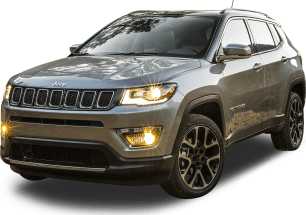The Compass sits in the small-SUV category but its larger dimensions mean it’s almost big enough to compete with models in the medium-SUV segment.
It’s longer, taller, wider and has a longer wheelbase than other larger small SUVs like the Kia Seltos and Honda HR-V, but isn’t as big as a mid-size Mazda CX-5.
It feels larger inside than other models it shares a platform with – namely the Jeep Renegade and Fiat 500X, that are no longer sold in Australia.
The biggest change ushered in by the update is the interior. Jeep has completely overhauled the cabin to the point that it’s unrecognisable compared to the pre-facelifted model.
The new dash design is much more appealing and the layout is well executed. There’s a mixture of soft-touch materials and plastic panels with red stitching running across the fascia. It’s so much more up-to-date than the old Compass and there’s a robust yet semi-premium look to the cabin.
A new steering wheel is in keeping with Jeep’s new generation of models that includes the Grand Cherokee due in Australia this year. It’s chunky, feels nice to touch and features clear audio, phone and cruise controls.
Jeep has persisted with its quirk of housing the volume and song/station skip buttons on the rear side of the steering wheel spokes. Once you remember which side volume lives (the right), it’s easy to change the levels. But surely it would be better to house them on the front of the wheel, with labels?
Storage wise, the glove box is narrow, as is the central bin, but it’s deep. The doors will hold 600ml bottles and the console houses two decent-sized cupholders with durable rubber lining which is easy to clean and can take a beating. The cupholders are separated by an upright phone holder.
Speaking of durable, that’s clearly the theme Jeep is going for with the Compass Trailhawk interior. It comes standard with rubber mats throughout, including the boot, which is great for protecting the carpet if you fancy a bit of camping.
What isn’t durable, however, is the cheap and tacky indicator stalk that feels like it will snap off every time you touch it.
After spending some time in European cars prior to the Jeep, it’s nice to experience strong air flow from the air conditioning system, especially at the height of a Melbourne summer. It’s also great to see physical buttons for the air con controls.
You can, however, also control the climate via the latest 'Uconnect 5' multimedia system housed in the 10.1-inch touchscreen.
This system is undoubtedly one of the Compass’ strong points. The modern graphics look very cool and the main icons make sense.
Once you dive into the menu there are extensive options but it’s not overwhelming. It’s intuitive and clever. The sat-nav visuals are clear and appealing too.
It’s an excellent set-up and better than systems from a whole host of Jeep’s mainstream rivals.
Apple CarPlay set-up was easy but there is an odd lag when selecting a command on the touchscreen that isn’t there when you use the Jeep system.
Another highlight is the exceptional Alpine nine-speaker audio system that’s part of the Trailhawk Premium package. It’s a belter!
The new digital instrument cluster has clear dials but changing the screen layout is fiddly. The Compass also lacks a head-up display.
The front seats with red embossed Trailhawk across the front look good, but the cushion feels like it’s elevating you in the seat. It’s not a problem with the power adjustment, it’s just the way the cushioning is designed. Thigh support is limited but upper body bolstering is good.
Visibility is impacted by the narrow rear windscreen and the tiny rear windows behind the C-pillar, that are pointless.
Rear occupants have access to lower air vents, a USB-A and USB-C port, 230-volt AC plug and a 12-volt DC plug. There are two map pockets, rubber floor mats and 600ml bottles will just fit in the door.
Space wise, there’s plenty of leg and toe room in the rear, and just enough headroom for this six-footer to avoid scraping the headliner.
Getting in and out of the front and rear seats is easy thanks to the Compass’ ride height.
The rear seats are flat and firm and the 60/40 split-fold seats have a fold-down central armrest with two cupholders.
When you open the power tailgate, the boot doesn’t look particularly big, but at 438 litres (1251L with rear seats folded), it’s five litres more than the Kia Seltos GT-Line and eight more than the Haval Jolion.
A full-size spare wheel lives under the boot floor and the cargo area features metal tie-down hooks and a small storage tray.
The cargo blind is useful but there’s nowhere to stow it when it’s not in use. And you have to lower the rear seats when you want to put it back in place.






